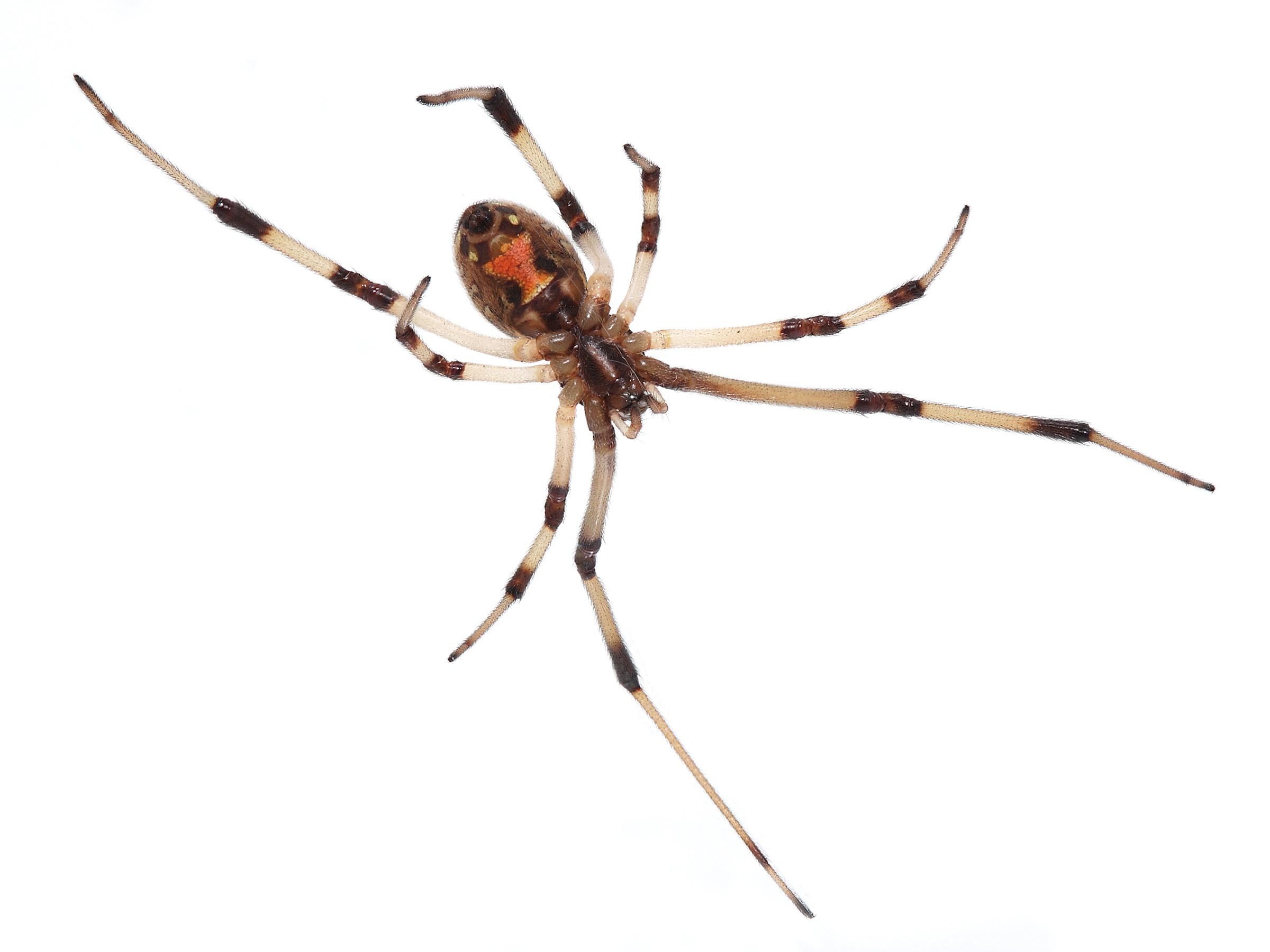Brown Widow Spider on:
[Wikipedia]
[Google]
[Amazon]
''Latrodectus geometricus'', commonly known as the brown widow, brown button spider, grey widow, brown black widow, house button spider or geometric button spider, is one of the widow spiders in the genus '' Latrodectus''. As such, it is a 'cousin' to the more infamous '' Latrodectus mactans'' (black widow). ''L. geometricus'' has black and white patterns on the sides of its abdomen as well as an orange-yellow colored hourglass shape. Their eggs are easily identified by points that project from all over the egg sacs. ''L. geometricus'' are found all over the world, but are believed to originate in South America. Their bites, though painful, are not considered to be dangerous.



Sexual Cannibalism in the Brown Widow Spider (''Latrodectus geometricus'')
{{Authority control geometricus Cosmopolitan spiders Spiders described in 1841 Taxa named by Carl Ludwig Koch Arthropods of the Dominican Republic



Taxonomy
''L. geometricus'' derives its name from the geometric patterning on its abdomen. However, the spider's coloring can and does darken over time and the pattern may become obscured. Similar widows include the ''L. rhodesiensis'', a brown-colored relative of ''L. geometricus'' which is native to Zimbabwe. Both species are collectively known as brown button spiders throughout southern Africa.Description
''L. geometricus'' is slightly smaller and generally lighter in color than theblack widow
Black widow may refer to:
Spiders
* Black widow spider, a common name for some species of spiders in the genus ''Latrodectus''
American species
* ''Latrodectus apicalis'', the Galapagos black widow
* ''Latrodectus curacaviensis'', the South Amer ...
species; the color can range from tan to dark brown to black, with shades of grey also possible. Like the black widow species in the United States, ''L. geometricus'' has a prominent hourglass-shaped marking on the underside of the abdomen; the brown widow's hourglass, however, is usually a vivid orange or a yellowish color. Unlike the black widow, ''L. geometricus'' has a black-and-white geometric pattern on the dorsal side of its abdomen. They also have stripes on their legs.
Brown widows can be located by finding their egg sacs, which are easily identifiable. They resemble a sandspur, having pointed projections all over, and they are sometimes described as "tufted", "fluffy", or "spiky" in appearance. Eggs hatch in approximately 20 days. Female brown widows lay about 120–150 eggs per sac and can make 20 egg sacs over a lifetime.
Predators
Because ''L. geometricus'' is dispersed all around the globe, they have many predators. Brown widows are commonly preyed upon by different types of wasps, including mud daubers and digger wasps.Geographic distribution
The brown widow has a cosmopolitan distribution. The World Spider Catalog gives its native distribution as Africa, with introductions to the Americas, Poland, the Middle East, Pakistan, India, Thailand, Japan, China, Papua New Guinea, Australia and Hawaii. It is thought by some researchers to originate in South Africa, although this is uncertain, as specimens were discovered in both Africa and South America. They are usually found around buildings in tropical areas. They can compete with populations of the black widow spider. It is found in many areas of South Africa, the United States (including Hawaii),Australia
Australia, officially the Commonwealth of Australia, is a Sovereign state, sovereign country comprising the mainland of the Australia (continent), Australian continent, the island of Tasmania, and numerous List of islands of Australia, sma ...
, Japan
Japan ( ja, 日本, or , and formally , ''Nihonkoku'') is an island country in East Asia. It is situated in the northwest Pacific Ocean, and is bordered on the west by the Sea of Japan, while extending from the Sea of Okhotsk in the north ...
, the Dominican Republic, and Cyprus.
Threat to native species
As of 2012, researchers at the University of California, Riverside, suggested that the brown widow spider, newly established in Southern California, may in fact be displacing black widow spiders from the region, competing and/or fighting for territory. While certainly not definitive, this evidence does suggest that the brown widow is likely to be more hostile and aggressive towards its relative, theblack widow
Black widow may refer to:
Spiders
* Black widow spider, a common name for some species of spiders in the genus ''Latrodectus''
American species
* ''Latrodectus apicalis'', the Galapagos black widow
* ''Latrodectus curacaviensis'', the South Amer ...
, than the black widow is towards it. If that proves to be true, humans may be positively affected since brown widow bites are less toxic than those of black widows, thus posing less of a threat as they displace black widows over time.
Toxicology
Like all ''Latrodectus'' species, ''L. geometricus'' has a neurotoxic venom. The venom acts on nerve endings causing the very unpleasant symptoms of latrodectism. However, brown widow bites are usually not very dangerous; usually much less dangerous than those of '' L. mactans'', the black widow. The effects of the toxin are usually confined to the bite area and surrounding tissue, unlike the black widow's. Mere toxicity of the venom is not the only factor in dangerousness. Brown widow bites are minor compared to black widow bites because they cannot deliver the same amount of venom as the black widow. The LD 50 of ''L. geometricus'' venom has been measured in mice as 0.43 mg/kg, and separately again as 0.43 mg/kg (with a 95% confidence interval of 0.31–0.53).References
External links
Sexual Cannibalism in the Brown Widow Spider (''Latrodectus geometricus'')
{{Authority control geometricus Cosmopolitan spiders Spiders described in 1841 Taxa named by Carl Ludwig Koch Arthropods of the Dominican Republic